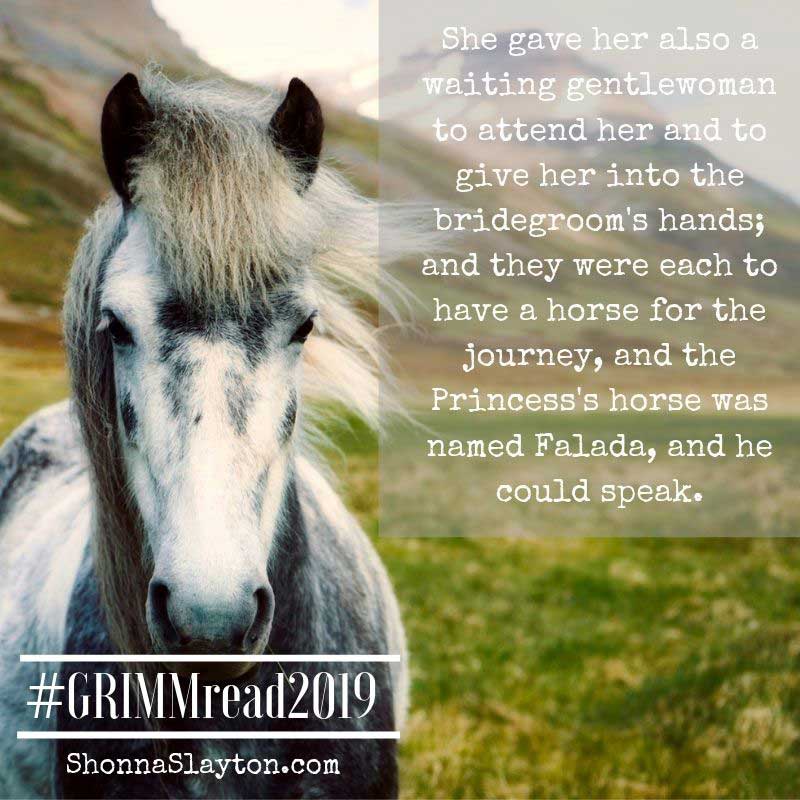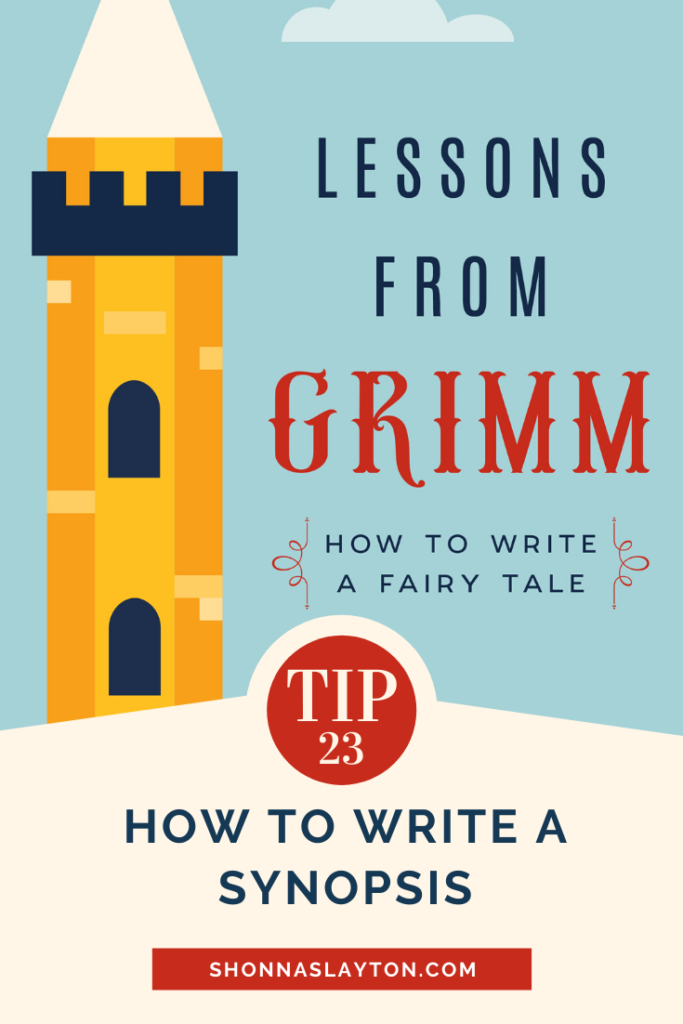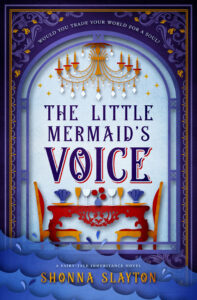Fairy tales in the original form of short stories have spawned countless retellings which flesh out their hidden parts into full-length novels. So, it follows that writers can learn to write the dreaded synopsis by using fairy tales as examples.
A synopsis as often part of a query package sent to agents and publishers. Even after an author is published and has a good relationship with her editor, she still has to submit a synopsis to outline her ideas for her next book. The synopsis never goes away.
A synopsis is supposed to hit the highlights of the story. What makes a synopsis hard to write is that writers are too close to the story. They know every detail, every subplot, every emotion. But too much information is overkill.
By looking at how these short stories in Grimm’s Fairy Tales are presented, we can learn how to present a complex story in two pages or less.
This week’s story, The Goose Girl, is a prime example.

In fact, you can read a synopsis of The Goose Girl on Wikipedia. It tallies in at 654 words, pretty much a one-page synopsis at 12pt Times New Roman.
The actual story translated into English is just over 2000 words, which amounts to about six pages. Technically, too long for a standard synopsis nowadays, where shorter is considered better (one or two pages), but a six page synopsis is not unheard of.
The beginning of the story sets up the overall premise and inciting incident:
There was once upon a time an old Queen whose husband had been dead for many years, and she had a beautiful daughter.
When the princess grew up she was betrothed to a prince who lived at a great distance. When the time came for her to be married, and she had to journey forth into the distant kingdom, the aged Queen packed up for her many costly vessels of silver and gold, and trinkets also of gold and silver; and cups and jewels, in short, everything which appertained to a royal dowry, for she loved her child with all her heart.
She likewise sent her maid in waiting, who was to ride with her, and hand her over to the bridegroom, and each had a horse for the journey, but the horse of the King’s daughter was called Falada, and could speak.
We’ve got our main characters: Queen, princess, prince, maid in waiting, Falada the horse—who could speak.
The inciting incident (what starts the story rolling) is the princess has to travel to a distant kingdom to get married.
This beginning also sets up the genre. We’ve got royalty, an upcoming marriage in a distant kingdom, and a talking horse. All these tropes signal FAIRY TALE.
The next part sets up some mystery, and foreshadows the beginnings of conflict:
So when the hour of parting had come, the aged mother went into her bedroom, took a small knife and cut her finger with it until it bled, then she held a white handkerchief to it into which she let three drops of blood fall, gave it to her daughter and said, “Dear child, preserve this carefully, it will be of service to you on your way.”
- Mystery: what can three drops of the queen’s blood do? And why?
- Foreshadows the beginnings of conflict: “it will be of service to you on your way” there must be trouble coming
- Note the descriptive words: aged, knife, bled, blood, preserve carefully.
So they took a sorrowful leave of each other; the princess put the piece of cloth in her bosom, mounted her horse, and then went away to her bridegroom. After she had ridden for a while she felt a burning thirst, and said to her waiting-maid, “Dismount, and take my cup which thou hast brought with thee for me, and get me some water from the stream, for I should like to drink.”
“If you are thirsty,” said the waiting-maid, “get off your horse yourself, and lie down and drink out of the water, I don’t choose to be your servant.”
Conflict revealed: The waiting-maid who was sent along to help the princess isn’t going to be any help. The princess is on her own for this journey, and will likely have problems with this maid.
And as she was thus drinking and leaning right over the stream, the handkerchief with the three drops of blood fell out of her bosom, and floated away with the water without her observing it, so great was her trouble.
The waiting-maid, however, had seen it, and she rejoiced to think that she had now power over the bride, for since the princess had lost the drops of blood, she had become weak and powerless. So now when she wanted to mount her horse again, the one that was called Falada, the waiting-maid said, “Falada is more suitable for me, and my nag will do for thee” and the princess had to be content with that.
Then the waiting-maid, with many hard words, bade the princess exchange her royal apparel for her own shabby clothes; and at length she was compelled to swear by the clear sky above her, that she would not say one word of this to any one at the royal court, and if she had not taken this oath she would have been killed on the spot.
First Plot Point (point of no return; the main character cannot go back to the way things were, she has to keep going forward until things are resolved): The waiting-maid usurps the princess and they switch roles. The maid is now riding Falada and dressed as the princess.
Here is my only quibble with using this story as an example of a synopsis—the modern agent or editor will want to know WHY the princess is allowing all this to happen. We know she’s lost her mother’s protection in the three drops of blood, but we don’t know how that works in this world. A synopsis is not the place to hold back secrets.
The waiting-maid now mounted Falada, and the true bride the bad horse, and thus they travelled onwards, until at length they entered the royal palace. There were great rejoicings over her arrival, and the prince sprang forward to meet her, lifted the waiting-maid from her horse, and thought she was his consort. She was conducted upstairs, but the real princess was left standing below.
Rising stakes: The waiting-maid has been accepted as the princess and now the real princess is left abandoned. We are left with questions that propel us to keep reading: How will she survive? Will she be able to convince anyone of who she really is?
Then the old King looked out of the window and saw her standing in the courtyard, and how dainty and delicate and beautiful she was, and instantly went to the royal apartment, and asked the bride about the girl she had with her who was standing down below in the courtyard, and who she was?
“I picked her up on my way for a companion; give the girl something to work at, that she may not stand idle.”
But the old King had no work for her, and knew of none, so he said, “I have a little boy who tends the geese, she may help him.” The boy was called Conrad, and the true bride had to help him to tend the geese.
Midpoint: The princess is at an all-time low in her life as she’s now been relegated to the position of goose-girl. Not even head-goose-girl, but a helper. This is the midpoint reversal. Literally, in this case. The maid has been made a princess, and now the princess has been made a servant.
Soon afterwards the false bride said to the young King, “Dearest husband, I beg you to do me a favour.”
He answered, “I will do so most willingly.”
“Then send for the knacker, and have the head of the horse on which I rode here cut off, for it vexed me on the way.” In reality, she was afraid that the horse might tell how she had behaved to the King’s daughter.
Dark moment: The evil maid has Falada the horse killed to secure her new role. Now the princess has no outside source to prove who she is. The dark moment leads directly into the second plot point.
Then she succeeded in making the King promise that it should be done, and the faithful Falada was to die; this came to the ears of the real princess, and she secretly promised to pay the knacker a piece of gold if he would perform a small service for her.
There was a great dark-looking gateway in the town, through which morning and evening she had to pass with the geese: would he be so good as to nail up Falada’s head on it, so that she might see him again, more than once. The knacker’s man promised to do that, and cut off the head, and nailed it fast beneath the dark gateway.
Early in the morning, when she and Conrad drove out their flock beneath this gateway, she said in passing,
“Alas, Falada, hanging there!”
Then the head answered,
“Alas, young Queen, how ill you fare!
If this your tender mother knew,
Her heart would surely break in two.”
Second Plot Point: The princess has Falada’s head saved and mounted where she could see it every day. Turns out, the horse can still talk. By the second plot point in the story, all information has been presented to the characters (and readers) for the plot to be resolved. This is the final “things set in motion” major plot point. Conrad has heard the horse calling the goose girl Queen.
Then they went still further out of the town, and drove their geese into the country. And when they had come to the meadow, she sat down and unbound her hair which was like pure gold, and Conrad saw it and delighted in its brightness, and wanted to pluck out a few hairs. Then she said,
“Blow, blow, thou gentle wind, I say,
Blow Conrad’s little hat away,
And make him chase it here and there,
Until I have braided all my hair,
And bound it up again.”And there came such a violent wind that it blew Conrad’s hat far away across country, and he was forced to run after it. When he came back she had finished combing her hair and was putting it up again, and he could not get any of it. Then Conrad was angry, and would not speak to her, and thus they watched the geese until the evening, and then they went home.
I’m not quoting the entirety of the story here; especially in this section as Conrad loses his hat more than once, but note that Conrad doesn’t say anything about what Falada revealed. He’s too busy trying to steal a few hairs from the princess (!) So, it could be that the second plot point could be bettered labeled as what happens next:
But in the evening after they had got home, Conrad went to the old King, and said, “I won’t tend the geese with that girl any longer!” “Why not?” inquired the aged King. “Oh, because she vexes me the whole day long.” Then the aged King commanded him to relate what it was that she did to him. And Conrad said, “In the morning when we pass beneath the dark gateway with the flock, there is a sorry horse’s head on the wall, and she says to it,
“Alas, Falada, hanging there!”
And the head replies,
“Alas, young Queen how ill you fare!
If this your tender mother knew,
Her heart would surely break in two.”And Conrad went on to relate what happened on the goose pasture, and how when there he had to chase his hat.
The aged King commanded him to drive his flock out again next day, and as soon as morning came, he placed himself behind the dark gateway, and heard how the maiden spoke to the head of Falada, and then he too went into the country, and hid himself in the thicket in the meadow. There he soon saw with his own eyes the goose-girl and the goose-boy bringing their flock, and how after a while she sat down and unplaited her hair, which shone with radiance.
Now the king knows the truth and this brings us to the climax and conclusion:
Then, quite unseen, he went away, and when the goose-girl came home in the evening, he called her aside, and asked why she did all these things.
“I may not tell you that, and I dare not lament my sorrows to any human being, for I have sworn not to do so by the heaven which is above me; if I had not done that, I should have lost my life.”
He urged her and left her no peace, but he could draw nothing from her. Then said he, “If thou wilt not tell me anything, tell thy sorrows to the iron-stove there,” and he went away.
Then she crept into the iron-stove, and began to weep and lament, and emptied her whole heart, and said, “Here am I deserted by the whole world, and yet I am a King’s daughter, and a false waiting-maid has by force brought me to such a pass that I have been compelled to put off my royal apparel, and she has taken my place with my bride-groom, and I have to perform menial service as a goose-girl. If my mother did but know that, her heart would break.”
The aged King, however, was standing outside by the pipe of the stove, and was listening to what she said, and heard it. Then he came back again, and bade her come out of the stove. And royal garments were placed on her, and it was marvellous how beautiful she was!
The aged King summoned his son, and revealed to him that he had got the false bride who was only a waiting- maid, but that the true one was standing there, as the sometime goose-girl.
The young King rejoiced with all his heart when he saw her beauty and youth, and a great feast was made ready to which all the people and all good friends were invited.
At the head of the table sat the bride-groom with the King’s daughter at one side of him, and the waiting-maid on the other, but the waiting-maid was blinded, and did not recognize the princess in her dazzling array. When they had eaten and drunk, and were merry, the aged King asked the waiting-maid as a riddle, what a person deserved who had behaved in such and such a way to her master, and at the same time related the whole story, and asked what sentence such an one merited?
Then the false bride said, “She deserves no better fate than to be stripped entirely naked, and put in a barrel which is studded inside with pointed nails, and two white horses should be harnessed to it, which will drag her along through one street after another, till she is dead.”
“It is thou,” said the aged King, “and thou hast pronounced thine own sentence, and thus shall it be done unto thee.” And when the sentence had been carried out, the young King married his true bride, and both of them reigned over their kingdom in peace and happiness.
Problems with the story that this synopsis reveals: An editor would likely point out that the princess is too passive. We aren’t told how she brings about her happily ever after. The way it’s written here, she lets everyone else do the work. You’d want to rewrite this to show how the main character has agency and how she uses it. These plot points can stay the same, but the princess ought to be working on her own behalf. We see her do this when she is able to save Falada’s head and bravely speaks out loud to him, and when she causes Conrad’s hat to fly away. We should see more scenes framed this way.
Also, you want to use dialogue sparingly in a synopsis, if at all. A synopsis isn’t supposed to be exactly like a short story.
Lastly, notice what is missing if we think of this as a synopsis. We don’t know the historical and political relationship between the two kingdoms, we don’t know any of the palace intrigue at either kingdom (who is working behind the scenes trying to make the wedding happen or trying to prevent it.) We don’t know where the goose girl is living or who she interacts with other than Conrad. We don’t know anything more about the power the princess lost when she lost the handkerchief. We don’t know anything about the prince! (However, if you were writing a YA story, you’d need to have more about the love interest in the synopsis!) All that we have are the highlights. No subplots. No nuance. Just a simplified story.
Almost everyone seems to hate writing a synopsis. But as you can see from The Goose Girl example, a synopsis doesn’t have to be dry and boring. It can tell a complete tale in a way that will make an agent or editor take notice and hopefully request the manuscript.




